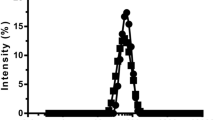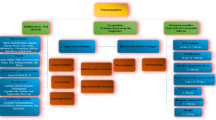Abstract
Double hydrophilic diblock copolymers based on asymmetric chemically complementary methoxypoly(ethylene oxide) and poly(acrylic acid) formed special micellar structures of the “cut” and “hairy” types with a complex “core” in aqueous solutions at pH < 5. These micelles have proven to be very effective, non-toxic, biocompatible, and biodegradable nanocarriers for the delivery of a poorly soluble vitamin E analogue, α-tocopheryl acetate, to sows and piglets. The obtained compositions of α-tocopheryl acetate with both types of micellar carriers showed high stability over time in a wide range of pH 3.5–9.0 and in physiological solution. However, in the case of “hairy” micelles, the developed “corona” of longer unbound segments of the polyacrylic acid block provided more reliable protection of the encapsulated drug molecules from the “salting-out” effect. The gradual release of the vitamin E analogue from both micellar nanocarriers into the aqueous and aqueous/salt medium under the action of the concentration gradient of α-tocopheryl acetate has been proved. The rate and efficiency of drug release were determined by the structure, morphology and stability of micellar carriers, as well as by the nature of the environment. The composition of α-tocopheryl acetate with one of the nanocarriers was tested in vivo on a group of sows as a dietary supplement. The positive effect of the micellar form of the drug on metabolic processes in sows, as well as on increasing the productivity of sows, stress resistance and safety of born piglets has been established.










Similar content being viewed by others
References
Amazan D, Cordero G, López-Bote CJ, Lauridsen C, Rey AI (2014) Effects of oral micellized natural vitamin E (d-α-tocopherol) v. synthetic vitamin E (dl-α-tocopherol) in feed on α-tocopherol levels, stereoisomer distribution, oxidative stress and the immune response in piglets. Animal 8(3):410–419
Dibbern H-W, Müller RM, Wirbitzki E (2002) UV and IR spectra. Pharmaceutical substances (UV and IR) and pharmaceutical and cosmetic excipients (IR). ECV Editio Cantor Verlag, Aulendorf
Directive 2010/63/EU of the European Parliament and of the Council of 22 September 2010 as to protection of animals used for scientific purposes (2010). In: Chapter 15(028), Special edition in Croatian, pp 82–128. http://data.europa.eu/eli/dir/2010/63/oj
Duhem N, Danhier F, Préat V (2014) Vitamin E-based nanomedicines for anti-cancer drug delivery. J Control Release 182:33–44
Gordon D (1979) Organicheskaya ximiya rastvorov e`lektrolitov. Mir, Moscow
Hsu C-Y, Wang P-W, Alalaiwe A, Lin Z-C, Fang J-Y (2019) Use of lipid nanocarriers to improve oral delivery of vitamins. Nutrients 11(1):68–97. https://doi.org/10.3390/nu11010068
Jalali N, Moztarzadeh F, Mozafari M, Asgari S, Motevalian M, Alhosseini SN (2011) Surface modification of poly(lactide-co-glycolide) nanoparticles by d-alpha-tocopheryl polyethylene glycol 1000 succinate as potential carrier for the delivery of drugs to the brain. Coll Surf A 392(1):335–342
Jing Z, Xu A, Liang Y-Q, Zhang Z, Yu C, Hong P, Li Y (2019) Biodegradable poly(acrylic acid-co-acrylamide)/poly(vinyl alcohol) double network hydrogels with tunable mechanics and high self-healing performance. Polymers 11(6):952–969. https://doi.org/10.3390/polym11060952
Kafilzadeh F, Kheirmanesh H, Karami Shabankareh H, Targhibi MR, Maleki E, Ebrahimi M, Yong Meng G (2014) Comparing the effect of oral supplementation of vitamin E, injective vitamin E and selenium or both during late pregnancy on production and reproductive performance and immune function of dairy cows and calves. Sci World J 2014:1–5. https://doi.org/10.1155/2014/165841
Kolakkandy S, Pratihar S, Aquino AJA, Wang H, Hase WL (2014) Properties of complexes formed by Na+, Mg2+, and Fe2+ binding with benzene molecules. J Phys Chem A 118:9500–9511
Kwon GS, Forrest ML (2012) Micelle composition of polymer and passenger drug. U.S. Patent US 8 173 167 B2; May 8 2012
Lazim N, Muhamad II (2017) Encapsulation of vitamin E using maltodextrin/sodium caseinate/selenomethionine and its release study. Chem Eng Transactigns 56:1951–1956
Li P, Li Z, Huang J (2007) Water-soluble star brush copolymer with four arms composed of poly(ethylene oxide) as backbone and poly(acrylic acid) as side chain. Macromolecules 40:491–498
Lv S, Gu J, Zhang R, Zhang Y, Tan H, McClements DJ (2018) Vitamin E encapsulation in plant-based nanoemulsions fabricated using dual-channel microfluidization: formation, stability, and bioaccessibility. J Agric Food Chem 66(40):10532–10542. https://doi.org/10.1021/acs.jafc.8b03077
Makovetskiy V, Maksin V, Kurapova T, Vlasenko S (2010) The investigation of antiradical and antioxidant activity of oxychroman and trimethylphenol MV-derivatives. Life Environ Sci 1–2:28–33. https://journals.nubip.edu.ua
Martins JT, Cerqueira MA, Vicente AA (2012) Influence of a-tocopherol on physicochemical properties of chitosan-based films. Food Hydrocolloids 27(1):220–227
Mishra MK (2019) Applications of encapsulation and controlled release. CRC Press, New York
Muddineti OS, Ghosh B, Biswas S (2016) Current trends in the use of vitamin E-based micellar nanocarriers for anticancer drug delivery. Expert Opin Drug Deliv 14(6):715–726
Permyakova NM, Zheltonozhskaya TB, Beregova TV, Klymchuk DO, Falalyeyeva TM, Grishchenko LN (2016) Micellar nanocarriers for anticancer drug melanin. Mol Cryst Liq Cryst 640(1):122–133
Permyakova N, Zheltonozhskaya T, Ignatovskaya M, Maksin V, Iakubchak O, Klymchuk D (2018) Stimuli-responsive properties of special micellar nanocarriers and their application for delivery of vitamin E and its analogues. Coll Polym Sci 296:295–307
Quintero C, Vera R, Perez LD (2016) α-Tocopherol loaded thermosensitive polymer nanoparticles: preparation, in vitro release and antioxidant properties. Polímeros 26(4):304–312
Salami SA, Guinguina A, Agboola JO, Omede AA, Agbonlahor EM, Tayyab U (2016) Review: in vivo and postmortem effects of feed antioxidants in livestock: a review of the implications on authorization of antioxidant feed additives. Animal 10(8):1375–1390
Santos RKS, Novais AK, Borges DS, Alves JB, Dario JGN, Frederico G, Pierozan CR, Batista JP, Pereira M Jr, Silva CA (2019) Increased vitamin supplement to sows, piglets and finishers and the effect in productivity. Animal 2019:1–9. https://doi.org/10.1017/S1751731119001927
Shelton NW, Dritz SS, Nelssen JL, Tokach MD, Goodband RD, DeRouchey JM, Yang H, Hill DA, Holzgraefe D, Hall DH, Mahan DC (2014) Effects of dietary vitamin E concentration and source on sow, milk, and pig concentrations of α-tocopherol. J Anim Sci 92:4547–4556. https://doi.org/10.2527/jas2013-7311
Shen H, Zang L, Eisenberg A (1997) Thermodynamics of crew-cut micelle formation of polystyrene-b-poly(acrylic acid) diblock copolymers in DMF/H2O mixtures. J Phys Chem B 101:4697–4708
Singh AK, Bhakat C, Kumari T, Mandal DK, Chatterjee A, Karunakaran M, Dutta TK (2020) Influence of pre and postpartum alpha-tocopherol supplementation on milk yield, milk quality, and udder health of Jersey crossbred cows at tropical lower Gangetic region. Vet World 13(9):2006–2011
Sounderya N, Zhang Y (2008) Use of core/shell structured nanoparticles for biomedical applications. Recent Patents Biomed Eng 1:34–42
Suntres ZE (2011) Liposomal antioxidants for protection against oxidant-induced damage. J Toxicol 2011:1–16. https://doi.org/10.1155/2011/152474
Wang L, Xu X, Su G, Shi B, Shan A (2016) High concentration of vitamin E supplementation in sow diet during the last week of gestation and lactation affects the immunological variables and antioxidative parameters in piglets. J Dairy Res 84(01):8–13. https://doi.org/10.1017/S0022029916000650
Yang Y, Decker EA, Xiao H, McClements DJ (2015) Enhancing vitamin E bioaccessibility: factors impacting solubilization and hydrolysis of α-tocopherol acetate encapsulated in emulsion-based delivery systems. Food Funct 6(1):84–97. https://doi.org/10.1039/c4fo00725e
Zheltonozhskaya T, Partsevskaya S, Gorchev V, Klymchuk D (2014) Processes of encapsulation and crystallization of prednisolone in PAAm-b-PEO-b-PAAm micellar solutions. Mol Cryst Liq Cryst 590:140–148
Acknowledgements
The authors are grateful for the financial support provided by Institute of Macromolecular Chemistry of National Academy of Sciences of Ukraine, National University of Life and Environmental Sciences of Ukraine and Taras Shevchenko National University of Kyiv of Ukraine. Additionally, this work was also partially supported by Institute of Botany of National Academy of Sciences of Ukraine.
Author information
Authors and Affiliations
Corresponding author
Ethics declarations
Conflict of interest
The authors hereby declare that they have no conflict of interest.
Additional information
Publisher's Note
Springer Nature remains neutral with regard to jurisdictional claims in published maps and institutional affiliations.
Rights and permissions
About this article
Cite this article
Permyakova, N.M., Zheltonozhskaya, T.B., Karpovsky, V.I. et al. Compositions of α-tocopheryl acetate with micellar nanocarriers and their possible use as biologically active additives. Appl Nanosci 12, 1295–1313 (2022). https://doi.org/10.1007/s13204-021-01996-0
Received:
Accepted:
Published:
Issue Date:
DOI: https://doi.org/10.1007/s13204-021-01996-0




